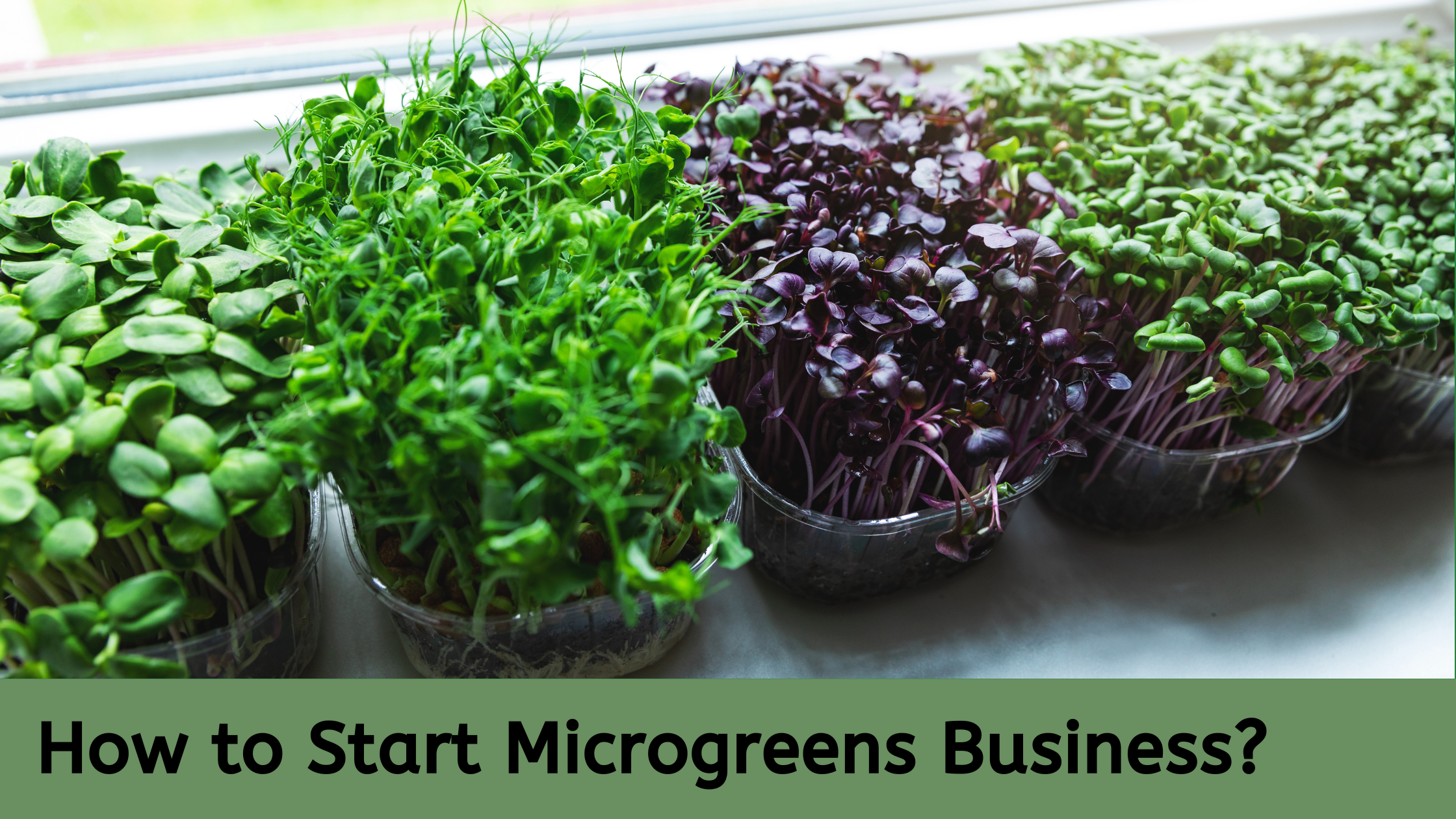How to Start a Microgreens Business? Sell Microgreens for Profit

Are you ready to turn a small space into a green goldmine? Welcome to the rapidly growing world of microgreens—a sector where tiny leaves translate into big profits.
In recent years, growing and selling microgreens has blossomed into an industry with an explosive annual growth rate, captivating chefs, health enthusiasts, and eco-conscious consumers alike.
With some varieties fetching upwards of $50 per pound for each tray of microgreens, the potential profitability for entrepreneurs is enormous. This isn’t just farming; it’s a strategic business opportunity that combines sustainability with profitability.
In this guide, you’ll be equipped with everything you need to start selling microgreens for profit, turning what may seem like small business into a successful, green-thumbed empire.
Get ready to sow the seeds of your future in microgreens farm and growing microgreens to sell for profit.
12 Best Side Hustles For Farmers To Boost Your Income From Your Farm
Understanding Microgreens
Microgreens are more than just a trendy ingredient on gourmet dishes; they are a testament to the saying “small but mighty.” These young vegetable greens are harvested just after the cotyledon leaves have developed, and in some cases, when the first true leaves emerge. This stage of growth typically occurs about one to three weeks after germination, depending on the species. Microgreens pack a nutritional punch, often containing higher vitamin, mineral, and antioxidant levels than the same plants at full maturity. Their delicate textures, vibrant colors, and diverse flavors ranging from sweet to spicy make them a favorite among chefs and food enthusiasts.
What Are Microgreens?
Microgreens are the seedlings of edible vegetables and herbs harvested at an early growth stage. Unlike sprouts, microgreens are grown in soil or soil substitutes, require sunlight for growth, and are harvested above the soil line—leaving the roots behind. This method of cultivation results in a product that is not only rich in flavor but also free from the soil and bacteria that can be a concern with sprout cultivation.
Here are some different type of microgreens:
- Arugula: Known for its peppery flavor, arugula microgreens add a spicy kick to salads, sandwiches, and garnishes.
- Broccoli: These microgreens offer a mild, slightly bitter taste and are packed with vitamins A and C, calcium, iron, and phosphorus.
- Radish: Radish microgreens are known for their spicy flavor and crisp texture, making them a great addition to salads and dishes needing a peppery zest.
- Pea Shoots: Offering a sweet, tender flavor, pea shoots are excellent in salads, stir-fries, or as a garnish.
- Sunflower: Known for their nutty taste and crunchy texture, sunflower microgreens are a nutritious addition to any dish.
- Kale: Kale microgreens provide a milder flavor than mature kale and are loaded with vitamins K, C, and A, along with essential minerals.
Each type of microgreen varies in taste, texture, and nutritional content, providing a broad palette from which to choose for culinary use or health-focused consumption. Their rapid growth cycle and minimal space requirement make microgreens an attractive crop for urban farmers and commercial growers alike, offering a sustainable and profitable venture for those interested in the agriculture of the future.
How To Sell Honey: A Sweet Source Of Cash!
Why Start a Microgreens Business?
Starting a microgreens business offers an innovative path for entrepreneurs looking to tap into the agricultural industry with a venture that is both environmentally sustainable and economically rewarding. The allure of microgreens lies not just in their nutritional value but also in their versatility and growing demand, making them an attractive option for those aiming to sell microgreens for profit. Here’s an expanded look into why embarking on a microgreens startup could be a fruitful endeavor:
Environmental and Economic Advantages
Microgreens can be grown with minimal space and resources, making them an ideal choice for urban farmers or those with limited outdoor space. Utilizing methods like hydroponic microgreens cultivation, one can achieve high yields in a controlled environment, reducing water usage and eliminating the need for pesticides. This sustainable approach not only benefits the environment but also reduces costs, contributing to a higher profit margin for the business. Additionally, the startup costs for a microgreens business are relatively low, allowing entrepreneurs to start small and scale up as the business grows. This scalability is key to managing financial risk and ensuring the long-term success of your business.
Market Demand for Microgreens
The market for microgreens has seen substantial growth, driven by their popularity among health-conscious consumers, gourmet chefs, and at farmers’ markets. Microgreens, including varieties like broccoli microgreens, are sought after for their intense flavors and nutritional benefits. Selling microgreens directly to consumers at local markets or through subscription models can tap into the increasing desire for fresh, locally sourced produce. Furthermore, by conducting market research and developing a solid marketing plan, business owners can effectively reach and expand their customer base.
Planning Your Microgreens Business
Creating a Business Plan: The first step in launching a successful microgreens business is to develop a comprehensive business plan. This document will serve as your blueprint, detailing every aspect of your operation from initial concept to long-term growth. It’s crucial to ensure your business plan is well-structured, covering all bases to anticipate challenges and opportunities alike.
Importance of a Well-Structured Business Plan
A thorough business plan is indispensable. It not only helps you understand the financial dynamics and operational requirements of running your business but also proves essential in securing funding, should you need external support. This plan will guide you in making informed decisions, helping you navigate the complexities of the microgreens market.
- Defining Your Business Model: Understanding the type of microgreen business you wish to establish is foundational. Will you focus on conventional farming methods, or will you explore hydroponic microgreens for more efficient production? Your business plan will help delineate the path.
- Legalities and Registration: Before you can start selling your fresh microgreens, you’ll need to register your microgreens business and obtain the necessary business license. This process will vary depending on your location but is an essential step in becoming a registered business, which your business plan should address comprehensively.
- Market Analysis: To ensure the success of your business, you must understand your target market. This involves researching local market demands, identifying potential customers among local restaurants and grocery stores, and determining how to effectively market your microgreens as organic, should that align with your business ethos.
- Production Plan: Detailing your microgreens production process, including the organic seeds you plan to purchase and the estimated yield of microgreens per tray, is vital. This section should also outline the necessary equipment and supplies you need to start growing microgreens, whether at home or in a commercial space.
- Financial Planning: A successful business hinges on sound financial planning. Your Microgreens business plan should include pricing strategies for your microgreens, taking into account production costs and market rates, to ensure you run a profitable enterprise. It’s important to be flexible and willing to adjust your prices according to market demand and competition.
- Marketing and Sales Strategy: Developing a robust marketing plan is crucial for reaching your target audience. This could involve digital marketing efforts to reach a broader audience or direct engagement with local chefs and grocery stores to see if your product meets their needs.
- Operational Details: Running your business efficiently requires a clear understanding of daily operations, including microgreen production schedules, quality control measures, and distribution logistics. Your business plan should provide a detailed overview of how you plan to manage these operations.
- Growth Strategies: As your business develops, your plan should also outline potential strategies for scaling up. This might involve expanding your product line to include more microgreen varieties, exploring additional sales channels, or increasing your production capacity.
- Risk Management: Identifying potential risks and outlining strategies to mitigate them is an essential component of your business plan. This could range from dealing with crop failures to navigating market fluctuations.
- Launching Your Business: The final step in your business plan should detail how you intend to launch your microgreens business. This includes setting a timeline, planning an initial marketing blitz, and determining the key milestones you aim to achieve in your first year of operation.
A well-structured business plan is indispensable for anyone looking to start a microgreens business. It not only sets the stage for a successful launch but also provides a clear direction for growth and scalability. By incorporating these key elements into your business plan, you’ll be well-equipped to navigate the challenges of the agricultural industry and steer your microgreens business toward long-term success.
Understanding Your Market
When embarking on a microgreens business, one of the crucial steps to success involves thoroughly understanding your market. This means not only identifying who your target customers are but also conducting a competitive analysis to find your unique place in the market. Let’s dive into how you can effectively identify your target market and carve out a niche for your microgreens business.
Identifying Your Target Market
Your target market essentially defines whom you are selling to. For a microgreens business, this can broadly include restaurants, grocery stores, farmers’ markets, and direct consumers. Each segment has its unique needs and preferences:
- Restaurants: Chefs and restaurateurs are constantly in search of fresh, high-quality ingredients that can elevate their dishes. Microgreens are prized for their intense flavors and visual appeal, making them attractive to high-end restaurants and those focusing on healthy or gourmet cuisine.
- Grocery Stores: Offering microgreens in grocery stores can tap into the consumer demand for nutritious and easy-to-prepare foods. Organic and locally sourced microgreens can particularly appeal to health-conscious shoppers.
- Farmers Markets: Selling directly at farmers markets allows you to engage personally with consumers, tell your story, and explain the benefits of your microgreens. This direct selling approach can build a loyal customer base and allow for premium pricing based on freshness and quality.
- Direct Consumers: With the rise of online shopping, selling microgreens directly to consumers through a website or social media can reach those interested in home cooking, health, and nutrition. Subscription models or home delivery services can offer convenience and consistency to this group.
Competitive Analysis and Finding Your Niche
Conducting a competitive analysis involves researching other microgreens businesses in your area to understand their offerings, pricing, and marketing strategies. This step is crucial for identifying gaps in the market that you can fill. Consider the following:
- Unique Selling Proposition (USP): What makes your microgreens stand out? It could be unique varieties not offered by competitors, organic certification, or a commitment to sustainable growing practices. Your USP is what will attract customers to your business over others.
- Pricing Microgreens: Analyze how your competitors price their microgreens and identify opportunities to offer more value. Perhaps you can provide bulk pricing to restaurants or create bundled offers for direct consumers.
- Marketing Channels: Look at how competitors market their products and identify underutilized channels. If most competitors focus on farmers’ markets, perhaps there’s an opportunity to expand into online sales or direct-to-restaurant distribution.
- Quality and Variety: Assess the quality and variety of microgreens offered by competitors. Offering superior quality or a wider range of microgreens can help you capture a larger share of the market.
Finding your niche involves synthesizing this information to position your microgreens business in a way that appeals to your target market while differentiating you from competitors. Whether it’s specializing in exotic microgreens, focusing on sustainable and eco-friendly growing methods, or offering unmatched customer service and education on using microgreens, your niche is what will define your brand and attract customers.
Start Growing Microgreens
When diving into the world of microgreens cultivation, understanding the nuances of setting up your growing space is pivotal. Whether you’re planning to start a microgreens business from the comfort of your home or investing in a professional growing system, certain key requirements must be met to ensure the healthy growth of these nutrient-packed greens. Let’s explore the essentials for a microgreens growing operation and the considerations for setting up a home space versus professional systems, incorporating various relevant terms.
Essential Requirements for a Microgreens Growing Operation
- Space: The beauty of microgreens is their minimal space requirement. Whether you’re growing microgreens at home or in a larger commercial setting, efficiently utilizing your space is crucial. For home growers, a well-organized setup can fit into a small area such as a kitchen countertop or a spare room. In contrast, expanding your business will involve larger dedicated areas to accommodate increased production.
- Lighting: Adequate lighting is essential for the growth of healthy microgreens. While natural sunlight is beneficial, most microgreens growers rely on artificial lighting to ensure consistent light exposure. LED grow lights are a popular choice for their efficiency and low heat output, making them suitable for both home setups and professional operations.
- Temperature and Humidity Control: Maintaining the right temperature and humidity levels is vital for microgreens. Ideal conditions vary among different types of microgreens, but generally, a temperature range of 18-24°C (64-75°F) and humidity levels between 40% to 60% are recommended. Professional setups might use climate-controlled systems, while home growers can use humidifiers or dehumidifiers to manage these conditions.
Setting Up a Home Space vs. Professional Growing Systems
Home Space:
- Starting a microgreens business at home is an excellent way to enter the market with minimal investment. Home growers need to develop a business plan that outlines their operation’s scale and scope. This plan should consider the types of microgreens to cultivate, the target market (local chefs, farmers’ markets, direct consumers), and the strategy to market their microgreens effectively.
- The initial setup requires basic equipment that one can easily purchase, including growing trays, soil or hydroponic media, seeds, and grow lights. Microgreens at home offer the flexibility to experiment with different varieties and growing techniques, adjusting your prices and offerings based on local market research and customer feedback.
| Category | Details |
|---|---|
| Space Requirements | – Minimal space needed (e.g., kitchen countertop, windowsill, spare room) |
| – Ensure area has enough room for growing trays and is free from contaminants | |
| Lighting | – Natural sunlight or artificial grow lights (LEDs recommended for their efficiency and low heat output) |
| Temperature | – Ideal range: 18-24°C (64-75°F) |
| Humidity | – Ideal levels: 40% to 60% |
| Equipment Needed | – Growing trays or containers |
| – Quality seeds (choose organic if possible) | |
| – Growing medium (soil, coconut coir, etc.) or hydroponic setup | |
| – Spray bottle for watering | |
| – Grow lights (if not using natural sunlight) | |
| Microgreen Varieties | – Radish, broccoli, arugula, peas, sunflower, and mustard are popular choices for their ease of growing and taste |
| Watering | – Keep the medium moist but not waterlogged |
| – Use a spray bottle for gentle watering until seeds germinate, then bottom water to avoid mold and overwatering | |
| Harvesting | – Typically ready in 1-3 weeks, depending on the variety |
| – Harvest by cutting just above the soil level with clean scissors | |
| Care Tips | – Ensure good airflow to prevent mold |
| – Rotate crops or trays to ensure even light exposure and growth | |
| Starting Costs | – Relatively low; primarily for seeds, growing medium, trays, and optional grow lights |
| Potential Challenges | – Mold or fungal diseases due to overwatering or poor ventilation |
| – Inconsistent growth due to lack of light or incorrect temperature/humidity | |
| Marketing & Selling | – Local farmers’ markets, direct to consumers online, local restaurants |
| – Use social media and word-of-mouth to promote your microgreens | |
| Legal Considerations | – Check local regulations regarding selling food from home |
| – May need to obtain a business license or food safety certification depending on scale and region |
Professional Growing Systems:
- As your microgreens business grows, transitioning to a professional growing system can help scale up production and increase profitability. A more advanced setup might include automated watering systems, climate control, and larger growing racks designed to maximize space efficiency.
- Expanding your operation requires a comprehensive business plan that outlines the necessary investments in equipment and infrastructure. It’s also essential to obtain any additional business licenses and ensure compliance with local food safety regulations.
- Professional growers have the opportunity to reach out to a broader market, including wholesale to grocery stores and restaurants. This expansion necessitates a more strategic approach to selling, such as developing partnerships and consistent supply agreements with buyers.
| Category | Details |
|---|---|
| Space Requirements | – Larger, dedicated space such as a greenhouse or indoor room with controlled environment |
| – Space optimization for shelving and efficient layout to maximize production | |
| Lighting | – High-quality grow lights for consistent, year-round production (LED panels or fluorescent lights commonly used) |
| Temperature Control | – Climate control systems to maintain ideal growing conditions: 18-24°C (64-75°F) |
| Humidity Control | – Systems to keep humidity levels between 40% to 60%, including dehumidifiers or humidifiers as needed |
| Equipment Needed | – Commercial-grade growing trays or racks |
| – Automated or semi-automated watering systems | |
| – Climate control equipment (heating, cooling, humidity) | |
| – High-quality, consistent seed supply | |
| – Professional growing medium or hydroponic systems | |
| Microgreen Varieties | – Select based on market demand, growth rate, and profitability. Popular choices include radish, kale, arugula, and mustard. |
| Watering System | – Automated watering systems for efficiency and to reduce labor costs |
| – Bottom watering methods to minimize disease risk | |
| Harvesting Tools | – Professional harvesting equipment for efficiency and consistency |
| Sanitation & Safety | – Regular cleaning and sanitation protocols to ensure food safety |
| – Adherence to local food safety and handling regulations | |
| Startup Costs | – Higher initial investment for equipment, space, and setup |
| – Budget for ongoing costs such as utilities, seeds, medium, and labor | |
| Market Analysis | – Research and identify target markets (restaurants, grocery stores, specialty food stores, online) |
| – Develop a marketing and sales strategy to reach your audience | |
| Scaling Your Business | – Plan for scalability, including equipment upgrades, space expansion, and staff hiring |
| Legal & Licensing | – Obtain necessary business licenses and permits |
| – Ensure compliance with agricultural and food safety regulations | |
| Marketing & Sales | – Professional branding and packaging |
| – Develop relationships with wholesalers, restaurants, and retailers | |
| – Online marketing and direct sales strategies for broader reach |
In both scenarios, successful microgreens growers understand that the quality of the microgreens they produce—fresh, nutritious, and visually appealing—is paramount. This quality, along with strategic marketing and a solid business model, determines the success of the operation. Whether you’re cultivating microgreens at home or through a professional system, your business’s scalability will vary depending on how well you can meet your market’s demands and how effectively you can operate within your chosen setup.
Running Your Microgreens Business
Launching and managing a successful microgreens business encompasses a spectrum of considerations, from pricing strategies to marketing and scaling up to wholesale operations. Here’s a breakdown of essential components to help navigate the journey toward a thriving microgreens venture.
Pricing Your Microgreens
Factors Influencing the Price:
- Cost of Production: Understanding the total cost involved in growing your microgreens, including seeds, soil, water, and labor, is critical. This forms the baseline for your pricing strategy.
- Market Demand: The demand for microgreens in your area, especially for unique or organic varieties, can significantly influence pricing.
- Quality: Higher quality microgreens that are fresher and more nutrient-dense can command higher prices.
- Packaging: Innovative and sustainable packaging that extends shelf life and enhances product appeal can also justify higher price points.
Strategies for Setting Competitive Yet Profitable Prices:
- Research Your Local Market: Analyze what competitors charge and what customers are willing to pay.
- Adjust Your Prices Accordingly: Flexibility in pricing, based on cost, demand, and customer feedback, is key to staying competitive.
- Highlight Quality and Uniqueness: Justify your pricing by emphasizing the superior quality, nutritional value, and unique varieties of your microgreens.
Marketing and Selling Your Microgreens
Effective Marketing Strategies:
- Online Presence: A well-designed website and active engagement on social media platforms can widen your reach.
- Local Food Markets: Participating in local farmers’ markets allows you to connect directly with consumers, fostering loyalty and brand recognition.
- B2B Selling: Establishing relationships with restaurants, cafes, and grocery stores can ensure steady orders and broaden your market.
Building Relationships with Chefs, Grocery Stores, and Direct Consumers
- Reach Out to Local Chefs: Chefs appreciate quality ingredients. Offering samples or tailored packages can secure their interest and patronage.
- Partner with Grocery Stores: Establishing a presence in local grocery stores enhances visibility and accessibility to a wider customer base.
- Engage with Consumers: Direct interactions, whether through markets or online platforms, build trust and loyalty. Listen to feedback and adjust your offerings accordingly.
Become a Wholesale Microgreens Business
Transitioning to a wholesale operation can dramatically increase your business scale and revenue. This move requires:
- Enhanced Production Capacity: Scaling up your growing operations to meet larger orders consistently.
- Robust Quality Control: Maintaining high standards of quality to satisfy wholesale buyers.
- Efficient Distribution: Developing a reliable distribution system to ensure timely delivery.
Conclusion
Starting and running a successful microgreens business is a rewarding journey that requires careful planning, adaptability, and a focus on quality. From setting competitive prices to implementing effective marketing strategies and potentially scaling up to wholesale, each step offers opportunities for growth and success.
As you navigate the intricacies of the microgreens market, remember that your efforts contribute to a healthier, more sustainable food system. With dedication and strategic planning, you can turn your microgreens venture into a flourishing business. Take the plunge, embrace the challenges, and enjoy the rewards of making your mark in the microgreens industry.





